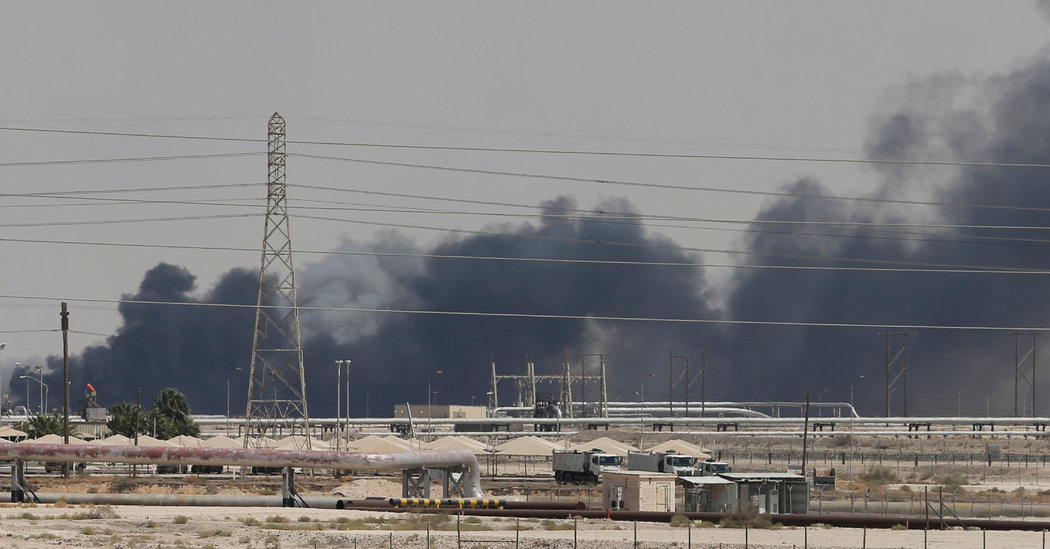Yemen’s Houthi rebels claimed responsibility for drone attacks on two key oil installations deep inside Saudi Arabia on Saturday, facilities that process the vast majority of the country’s output and raising the risk of a disruption in world oil supplies.
Secretary of State Mike Pompeo blamed Iran, which backs the Houthis, calling it “an unprecedented attack on the world’s energy supply” and asserting, “There is no evidence the attacks came from Yemen.”
It was the single most audacious attack on Saudi Arabia that the Houthis have claimed since the kingdom intervened in Yemen’s war more than four years ago, devastating the impoverished country and creating the world’s worst humanitarian crisis.
The two facilities can process 8.45 million barrels of crude oil a day between them, the bulk of production in Saudi Arabia, the world’s largest oil exporter. It was not immediately clear how badly the facilities were damaged, but shutting them down for more than a few days would affect global oil supply.
The attacks — some 500 miles from Yemeni soil — not only exposed a Saudi vulnerability in the its war against the Houthis, but demonstrated how relatively cheap it has become to stage such high-profile attacks. The drones used in Saturday’s attack may have cost $15,000 or less to build, said Wim Zwijnenburg, a senior researcher on drones at PAX, a Dutch peace organization.
The difference in resources available to the attacker and the victim could hardly have been greater, illustrating how David-and-Goliath style attacks using cheap drones are adding a new layer of volatility to the Middle East. Such attacks not only damage vital economic infrastructure, but can also increase security costs, disrupt markets and spread fear.
While the Houthis do not have significant financial resources, the drones have given them a way to hurt Saudi Arabia, which was the world’s third highest spender on military equipment in 2018, investing an estimated $67.6 billion on arms.
“This has given the Saudis a challenge they can’t confront, no matter what their financial, military or intelligence capabilities are,” said Farea Al-Muslimi, co-founder of the Sanaa Center for Strategic Studies, which focuses on Yemen.
The attacks hit deeper into Saudi territory than most previous strikes, and the Houthis claimed to have used 10 drones in the operation, which they said was one of the largest aerial operations they have carried out. It set off blazes whose smoke could be seen from space.
The war in Yemen began in 2014, when the Houthi rebels seized control of the capital and most of Yemen’s northwest, sending the government into exile. A coalition of Arab nations led by Saudi Arabia and the United Arab Emirates, with some support from the United States, began bombing Yemen in 2015, hoping to push the Houthis back and restore the government.
Instead, the war has settled into a stalemate and the Houthis have developed increasingly sophisticated ways of striking back at Saudi Arabia, most notably with drones. The first indications of the Houthis using drones emerged last year, and their capabilities have improved since.
The Houthis are part of a regional network of militant groups aligned with and backed by Iran, and United States and Saudi officials suspect that Iran has dispatched technicians to Yemen to train the Houthis on drone and missile technology.
The Houthis have attacked Saudi infrastructure before, primarily with less accurate ballistic missiles.
Mr. Zwijnenburg, the researcher, said the drones gave the Houthis an edge because they were cheap to produce, hard to detect and shoot down, and able to cause damage and disruption that was hugely disproportionate to their cost. While the Houthis’ exact capabilities are not known, they have clearly developed over time.
“They are learning to adapt their drone capabilities to specifically attack Saudi targets, avoiding detection, avoiding interception, which means that in the future they have a larger set of targets to choose from,” he said.
The Houthis’ alliance with Iran also raises the possibility that their successes could be shared with other Iran-aligned militant groups in Iraq, Syria and Lebanon, he added.
The strike on one of the centers hit, in Abqaiq, is particularly worrying because it processes crude from several key Saudi oil fields, said Helima Croft, an analyst at RBC Capital Markets, an investment bank.
“This is the mother lode for an attack on Saudi infrastructure,” she said. “We have always been concerned about an attack on Abqaiq.”
Whether world oil supplies are disrupted “will depend on the degree of the damage,” she said. Such a disruption could lead to a release of oil from the United States’ Strategic Petroleum Reserve.
Rapidan Energy Group, a Washington-based market research firm, called Abqaia by far the most important oil facility in the world and said repairing it could take months.
“A successful attack on Abqaiq is about the worst thing energy security planners think about,” because the specialized equipment there would be difficult to quickly replace, Robert McNally, Rapidan’s president and a former White House energy adviser under President George W. Bush, said in an interview.
If the damage turns out to be major, he said, the disruption could outlast Saudi oil supplies. The firm estimated the Saudis have 188 million barrels of oil on hand, or enough to cover a disruption of 5 million barrels per day for 37 days.
Mr. McNally predicted that oil traders would quickly “start doing the math,” potentially sending prices upward.
He added that this attack is “likely to put on ice” talk of easing sanctions on Iran, with the consequences depending on how closely Tehran can be linked to the attacks.
“Forget about easing sanctions,” he said. “We are talking about a step up on geopolitical risks.”
Sadad al-Husseini, a former senior executive of Saudi Aramco, the state-owned oil giant, said the company had enough reserves to keep world supplies steady if the plants were shut down for a few days. A long disruption would be another matter, analysts say.
While there were no reports of casualties, the attacks struck at the core of the Saudi economy. They came just as Aramco accelerated plans for what could be the largest initial public offering of stock in the world, an event being closely watched by investors around the world.
An Aramco spokesman declined to comment.
The Saudi interior ministry reported fires at the two processing centers, in Abqaiq and Khurais, before dawn on Saturday, and later said they had been attacked with drones. The ministry said both fires had been “controlled and contained,” the Saudi-owned news network Al Arabiya reported without any further details.
A Houthi spokesman, Brig. Gen. Yahya Sare’e, said in a statement broadcast by Al-Masirah, the faction’s news organization, that the group’s forces “carried out a massive offensive operation of 10 drones targeting Abqaiq and Khurais refineries.”
The Houthis — supported by Saudi Arabia’s chief rival in the region, Iran — have tried to take the fight to Saudi Arabia before. But those efforts have been pinpricks compared to the devastation in Yemen.
The conflict in Yemen has killed thousands of civilians, many of them in Saudi airstrikes using American-made weapons. It has also created a massive humanitarian crisis with millions at risk of starvation and millions of others homeless.
In a report presented to the United Nations Human Rights Council in Geneva last week, a panel of experts said both sides in the conflict were committing horrific human rights abuses, including arbitrary killings, rape and torture, with impunity. The atrocities underscored the collective failure of the international community, the panel said.
After a period of relative calm, following a cease-fire brokered late last year, tensions have escalated again in recent months. Houthi forces attacked Saudi pipelines and other oil infrastructure in May, temporarily halting the flow of crude oil, and in June they struck an airport in Saudi Arabia, wounding dozens of people.
In July, in a major blow to the Saudi-led coalition, the United Arab Emirates, which had been providing arms, money and, crucially, ground troops in Yemen, announced a rapid pullout from a conflict that had become too costly. The move left diplomats and analysts wondering whether Saudi Arabia would continue the war on its own.
Although the Trump administration has been a vocal supporter of Saudi efforts to deter Iran and its allies in the region, congressional opposition to the sale of arms and the deployment of extra troops in Saudi Arabia has limited the scope of support from the United States.















